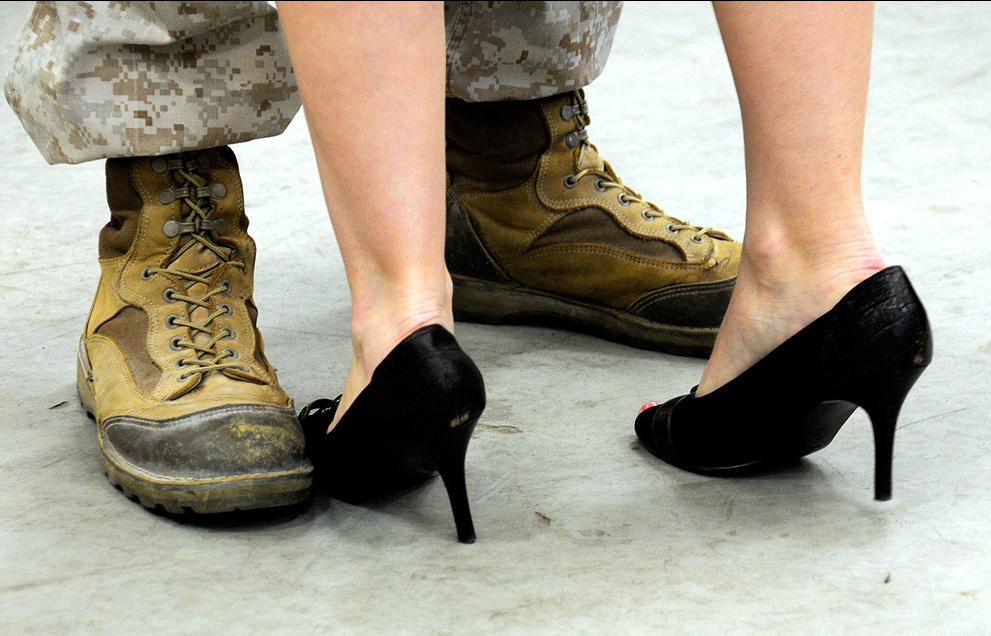Perhaps one of the most famous photographs to come out of World War II—or any war—is the image of a nurse and sailor kissing in New York’s Times Square. The “Times Square Kiss” is notable for many reasons and not least for the way in which it models the egalitarianism of the war effort (both sailor and nurse are in uniform), as well as for way in which it channels the public celebration of the end of the war (it was VJ day) through the spontaneous, heterosexual kiss of two anonymous individuals as they return to the “normalcy” of public life. If war marks the enforced separation of the sexes and uniformed repression of the yearnings of private life, the subordination of Eros to Thanatos, the “Times Square Kiss” signifies the release of long suppressed passions.
Photographs of returning sailors, soldiers, and marines kissing their loved ones upon return from overseas duty have become a photojournalistic convention and it is difficult to look at the many such images and not see their tribute to the image of the sailor and nurse in Times Square. Most such photos are full-bodied shots; the image above, however, taken recently in Washington, D.C. at the return of the 4th Civil Affairs Group, 2nd Marine Division from a 7 month deployment in Afghanistan, focuses only on a pair of feet, and in that fact the photograph seems to tell something of a different story.
There is no way to know for sure that they are kissing, of course, but the fact that her right foot rises above the floor and her weight seems to be firmly on her left foot suggests that she is leaning up and into a taller lover as if in an embrace. The contrast between heels and combat boots implies that this is a heterosexual kiss, just as with the original “Times Square Kiss,’ but nevertheless ambiguity reigns as even female Marines would surely wear combat boots. And more, photographs of public homosexual kisses between returning veterans and their loved ones is no longer a taboo (see here and here). If nothing else, then, the photograph gestures to the possibility of shifting mores within the public culture, or at the least to the uncertainty of otherwise longstanding stereotypes of cultural normalcy.
The primary difference between this photograph and the “Times Square Kiss,” and here there is no ambiguity, is the privacy of the scene being represented. And that privacy is marked in multiple ways. To begin, and most obviously, there is nothing in the image that would indicate that this is a public space. The flooring appears to be some kind of tile designed to look like marble, but it also has an indistinct, institutional quality about it that suggests that this could be just about anywhere—and nowhere in particular. More to the point, there is no indication of a viewing or witnessing public of any kind. The caption to the photograph notes that 35 Marines from this unit returned on this day, but of course there is no evidence of them whatsoever in the image. In all likelihood they too are engaged in kisses and embraces with loved ones, but if this photograph is to be an index of the event they too are in all likelihood involved in personal, individuated celebrations. The point is accentuated by the contrast between the combat boots and the high heels, both showing the scuff marks of normal, everyday wear that mitigates the distinction between military and civilian life. While the anonymity of the full-bodied kissers in the original photograph underscored their status as individuals standing in for the public at-large, here the solitary focus on their shoes identifies them as private individuals representing only themselves in a closed and private universe. Nor perhaps should this surprise us all that much. After all, the war in Afghanistan is the longest war in the nation’s history, and given that there is neither public consensus as to what our mission there is nor clarity regarding when it will actually end—promised schedules notwithstanding—it should come as no surprise that there is no public witnessing or celebration of such returns.
The original “Times Square Kiss” was often captioned “The Return to Normalcy” and here we might be witnessing something like the “The New Normalcy.” Whether we want to read that as a salutary world of changing mores concerning gender relations or as an increasingly frail, privatized world in which the public exercises no voice at all in such matters is a matter of what we choose to see.
Photo Credit: Staff Sgt. Brittany E. Jones/USMC

Just a correction to the photo credit. SSgt Brittany Jones who took the photo, is actually an Air Force Staff Sergeant working at Joint Base Anacostia-Bolling and is not a USMC Staff Sergeant as noted in the photo credit below the superb narrative describing the photo.
Roy: Thanks for the correction.